Did you know Bhutan’s National Day on December 17th is more than a holiday? It’s a grand celebration with rituals, dances, and cultural parades. This day marks the coronation of Bhutan’s first king, Ugyen Wangchuck, in 1907. It has grown into a showcase of Bhutan’s heritage and pride.
On this day, sacred rituals and mesmerizing mask dances highlight Bhutan’s history and its path to modernization. Citizens come together to honor their king and celebrate their national identity. The National Day is a time of unity and joy, featuring Bhutanese traditions and the iconic Bhutan Mascot.
Let’s dive into the wonders of this festival. Here, tradition and modernity blend, and cultural richness is celebrated with great enthusiasm.
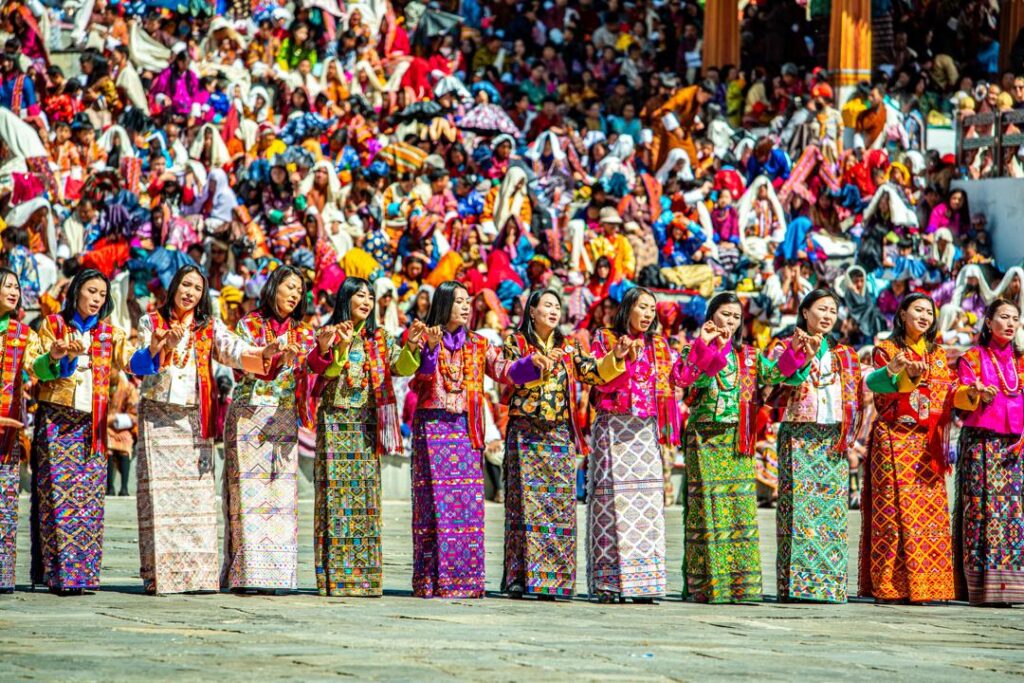
Introduction to Bhutan’s National Day
Bhutan’s National Day is celebrated on December 17th every year. It’s a big Bhutanese national celebration that shows national unity and pride. The whole country comes alive with color and joy, filled with cultural festivities that show off Bhutan’s rich heritage and shared history.
This special day is a chance for Bhutanese people to remember and honor their victories. It’s a time for the nation to come together and celebrate their progress. They also pay tribute to the cultural richness that makes Bhutan unique. The day is filled with a strong sense of national unity, bringing everyone together.
The day starts with solemn monastery rituals, setting a sacred tone. These rituals, held in many monasteries, include prayers and chanting led by respected monks. The Bhutan Mascot symbolizes the nation’s unity and cultural heritage, appearing in the celebrations to remind everyone of their shared identity and pride.
Bhutanese dances, including traditional mask dances and folk dances, are a big part of the festivities. These performances show off Bhutan’s artistic and cultural depth. They allow people of all ages to join in and enjoy the vibrant shows. These events entertain and strengthen the bonds of community and shared heritage among the Bhutanese people.
In short, Bhutan’s National Day is more than just a holiday. It’s a colorful mix of cultural expression and unity, woven together through centuries of tradition and collective pride.
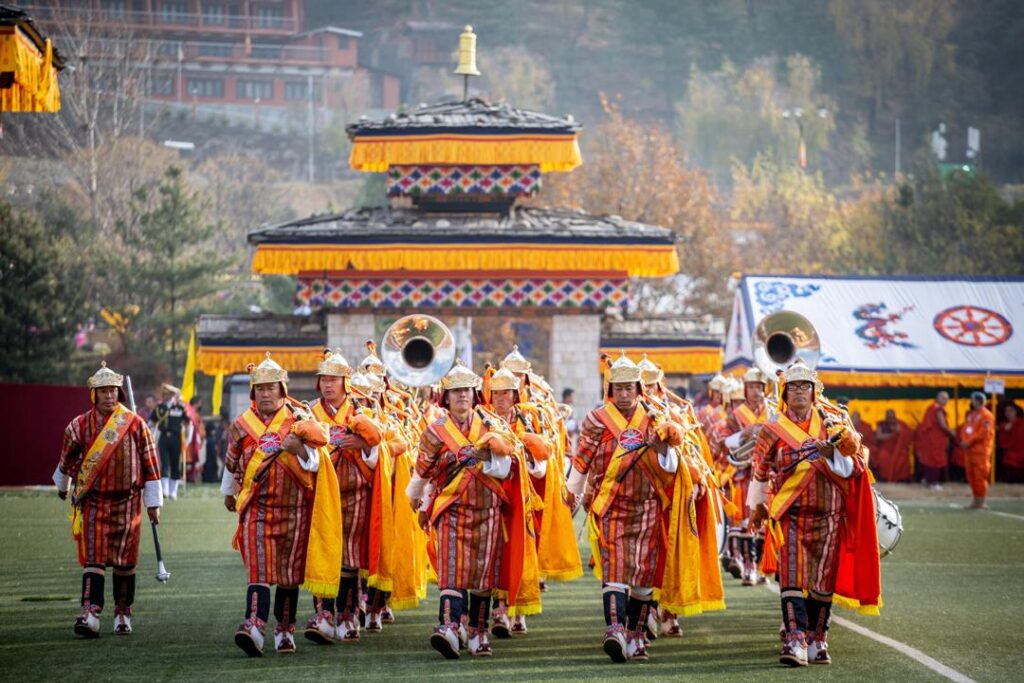
Origins and Significance of the National Day of Bhutan on 17th Dec
Bhutan celebrates its National Day on December 17th. This day honors the country’s history and its founding. It marks a key moment in Bhutan’s past.
The Birth of a Tradition
The first king, Ugyen Wangchuck, was crowned on December 17th, 1907. This event ended civil strife and united the kingdom. It started the traditions we celebrate today.
Why December 17th?
December 17th is a day of great historical importance. It celebrates Bhutan’s unity under one ruler. Today, it reminds us of our national unity and culture.
Bhutan Monastery Rituals: A Sacred Celebration
Bhutan, a country deeply rooted in Buddhism, celebrates its National Day with monastery rituals Bhutan. These rituals show the nation’s strong faith and cultural identity. They are a big part of Bhutanese life.
Morning Prayers and Chanting
On December 17th, the morning brings the sounds of morning prayers and chanting. These practices clean the air and set a peaceful mood for the day. Monasteries all over Bhutan join in, starting a spiritual day to honor their faith and country.
The Role of Monks in the Festival
Monks are key during the National Day. Their monastery rituals add a sacred touch to the celebrations. They lead prayers for the country’s and people’s well-being.
Their role shows how important Buddhism is in Bhutan. Monks help keep the traditions alive with great respect.
The Bhutan Mascot: Symbol of Unity and Culture
The Bhutan Mascot is a cherished symbol of Bhutan’s strength, pride, and unity. It is most visible during big celebrations like the National Day of Bhutan on December 17th. This emblem brings together the country’s diverse cultures, showing unity.
The mascot’s history goes back to a time when Bhutan wanted a shared identity. It represents the nation’s shared history and important values. At Bhutanese monastery rituals and dance performances, the mascot shows the cultural bond of Bhutan.
On National Day, the mascot brings people together to celebrate their heritage. It symbolizes the unity and sense of belonging that are key to Bhutan. People enjoy traditional activities, and the mascot reminds them of Bhutan’s values and traditions.
The Bhutan Mascot’s popularity shows its role in uniting the nation. It promotes a shared identity and respect among Bhutanese. This ensures Bhutan’s cultural legacy will live on for future generations.

Traditional Bhutanese Dance Performances
Dance is key to Bhutanese culture, especially on National Day. These shows give a colorful look into the country’s rich traditions and identity.
Mask Dances: A Visual Feast
The Mask Dances are Bhutan’s most famous dances. They are a sight to see, with detailed costumes and masks of deities and mythical beings. These dances tell stories that mix spiritual and historical themes.
But they do more than entertain. Mask Dances also have a religious role. They call upon deities and ask for blessings for the community.
Folk Dances: Celebrating Community
Folk Dances are another big part of Bhutanese culture. They bring people together, performed by locals who have learned from their elders. Dancing on National Day is fun and builds unity.
It strengthens community bonds and celebrates shared heritage.
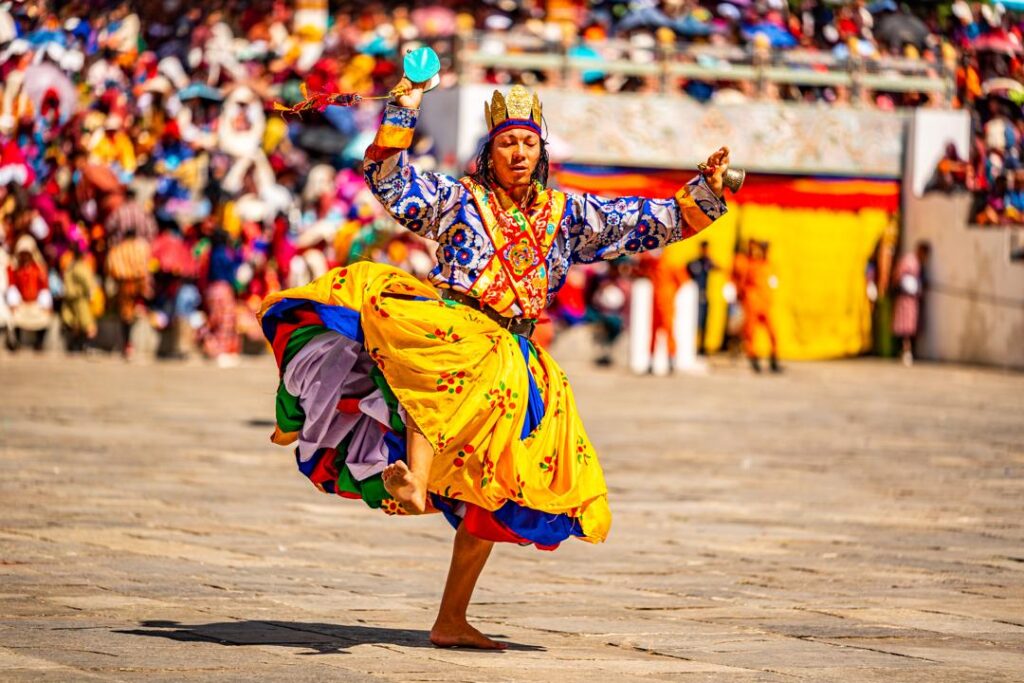
The Significance of Dzongs during the National Day
On Bhutan’s National Day, celebrated on December 17th, Dzongs are key to the celebrations. These fortress-monasteries are architectural wonders with deep historical value. They are the heart of cultural ceremonies and government events.
The Dzongs are both religious and administrative centers. They show the architectural significance of Bhutan. Their grand designs, with towering walls and intricate woodwork, amaze everyone. People gather here to join in and watch the National Day celebrations.
On National Day, Dzongs become lively centers of activity. They host cultural ceremonies like traditional dances and public honors. Government officials also hold important events here, adding to the day’s solemnity. This makes the Dzongs crucial to Bhutan’s celebrations.
The National Day highlights Bhutan’s cultural heritage through Bhutanese Dance performances and more. The Dzongs are not just silent witnesses to history. They actively participate in Bhutan’s ongoing traditions.
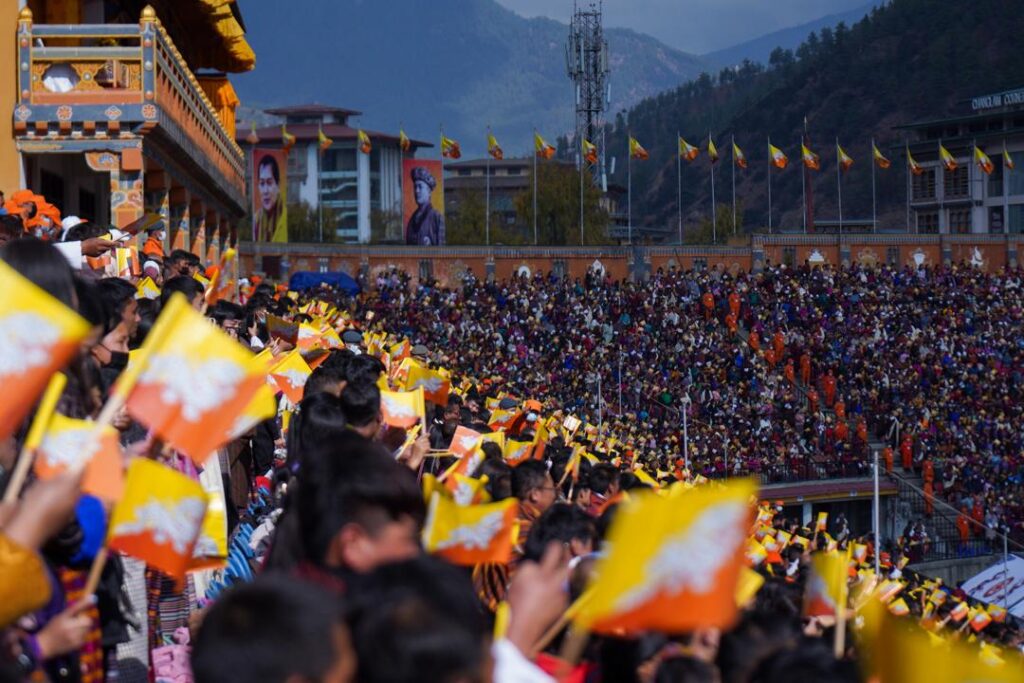
National Day, Festival of Bhutan: A Day of Unity and Joy
National Day in Bhutan is a special national unity celebration. It shows the joy and unity in Bhutanese society. On December 17th, the nation comes together through shared heritage and traditions.
This day is all about community spirit. It’s strengthened by cultural activities that weave everyone together.
Community Gatherings
Community gatherings are a big part of the festival. They show the vibrant spirit of the Bhutanese people. Villages and towns are filled with traditional decorations and joyous festivities.
At these gatherings, people sing, dance, and tell stories. They keep Bhutan’s rich culture alive. Traditional dances and a lively mascot make these events even more special, showing unity and joy.
Public Honoring of the King
The public honoring of the King is a key part of National Day. It shows deep loyalty and respect for the monarchy. On this day, the Bhutanese royal honor is clear in the ceremonies.
The King’s leadership and contributions are celebrated with excitement. Ceremonies include speeches, processions, and music. They highlight the monarchy’s role and strengthen the bond between the King and the people.
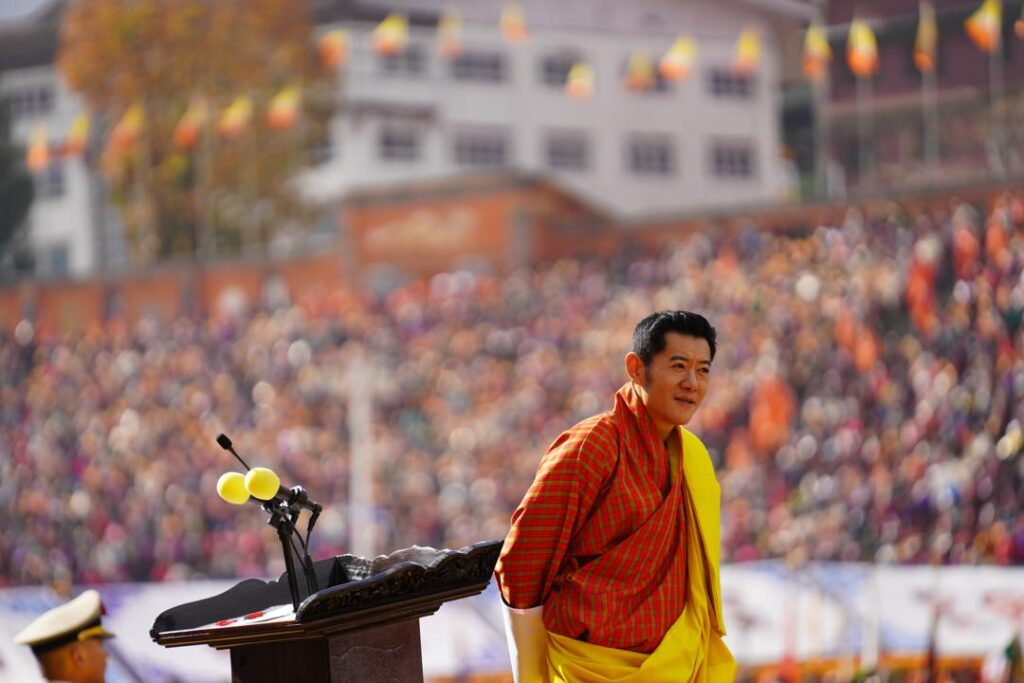
Culinary Delights: Iconic Bhutanese Food During the Festival
Bhutan’s National Day on December 17th is a time of cultural celebration and delicious food. Communities gather to honor this day, with Bhutanese cuisine at the center of the festivities.
The air is filled with the scent of traditional Bhutanese recipes. Each dish tells a story of Bhutan’s heritage. Ema Datshi, a chili and cheese dish, is a favorite. It symbolizes warmth and unity in the community.
Jasha Maru, a spicy chicken stew, is another favorite. It’s made with red rice and complex flavors. This dish brings families and friends together.
Don’t forget the sweet treats like Desi, a rice dessert with butter, sugar, and raisins. It’s served at festivals, celebrating joy and togetherness.
Suja, the traditional butter tea, is essential during celebrations. It’s enjoyed by all, adding warmth to the chilly December air.
These dishes reflect Bhutan’s culture. Preparing and sharing meals strengthens social bonds and celebrates Bhutanese identity.
As you enjoy Bhutanese Dance performances and bhutan monastery ritual, remember the food is the heart of the celebration.
The Role of Music in Bhutan’s National Day Celebrations
Music is at the heart of Bhutan’s National Day celebrations. It creates a vibrant and immersive experience for everyone. The enchanting sounds of traditional Bhutanese instruments fill the air, making the festival atmosphere even more festive.
This rich musical tradition entertains and connects the Bhutanese people to their heritage and history. It’s a powerful way to celebrate their roots.
Traditional Instruments
Traditional Bhutanese instruments are key to these celebrations. The dramyen, a six-stringed lute, and the lingm, a wooden flute, are essential. They add to the unique soundscapes that showcase Bhutan’s cultural richness and diversity.
The Rhythms of Celebration
The rhythmic patterns from these instruments are vital to the National Day festivities. From lively drumming to melodious tunes from the dramyen and lingm, the rhythms bring joy and unity. These musical elements entertain and evoke pride in Bhutan’s cultural identity.
Conclusion
Bhutanese National Day on December 17th is a big celebration of culture and pride. It shows off Bhutan’s traditions and brings people together. The day is filled with sacred rituals, traditional dances, and more, showing off the country’s rich culture.
The Bhutan Mascot symbolizes unity and culture. Traditional music adds to the festive mood. Public events honor the King, showing respect and gratitude.
Every part of the celebration, from Mask Dances to traditional food, shows a nation united by tradition and hope for the future. Bhutan’s National Day is a special time to look back, enjoy the present, and look forward to a future where old and new traditions blend.